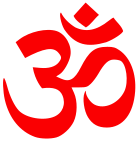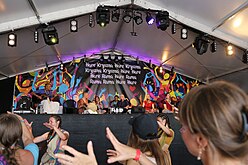
Back Mantra Afrikaans Mantra ALS مانترا Arabic Mantra Azerbaijani Mantra BAR Мантра Byelorussian Мантра Bulgarian মন্ত্র Bengali/Bangla མན་རྡ་ར། Tibetan Тарни BXR
A mantra (Pali: mantra) or mantram (Devanagari: मन्त्रम्)[1] is a sacred utterance, a numinous sound, a syllable, word or phonemes, or group of words (most often in an Indo-Iranian language like Sanskrit or Avestan) believed by practitioners to have religious, magical or spiritual powers.[2][3] Some mantras have a syntactic structure and a literal meaning, while others do not.[2][4]
ꣽ, ॐ (Aum, Om) serves as an important mantra in various Indian religions. Specifically, it is an example of a seed syllable mantra (bijamantra). It is believed to be the first sound in Hinduism and as the sonic essence of the absolute divine reality. Longer mantras are phrases with several syllables, names and words. These phrases may have spiritual interpretations such as a name of a deity, a longing for truth, reality, light, immortality, peace, love, knowledge, and action.[2][5] Examples of longer mantras include the Gayatri Mantra, the Hare Krishna mantra, Om Namah Shivaya, the Mani mantra, the Mantra of Light, the Namokar Mantra, and the Mūl Mantar. Mantras without any actual linguistic meaning are still considered to be musically uplifting and spiritually meaningful.[6]
The use, structure, function, importance, and types of mantras vary according to the school and philosophy of Jainism, Buddhism, Hinduism, Zoroastrianism, and Sikhism.[3][7] A common practice is japa, the meditative repetition of a mantra, usually with the aid of a mala (prayer beads). Mantras serve a central role in the Indian tantric traditions, which developed elaborate yogic methods which make use of mantras.[6][8] In tantric religions (often called "mantra paths", Sanskrit: Mantranāya or Mantramarga), mantric methods are considered to be the most effective path. Ritual initiation (abhiseka) into a specific mantra and its associated deity is often a requirement for reciting certain mantras in these traditions. However, in some religious traditions, initiation is not always required for certain mantras, which are open to all.[9][5]
The word mantra is also used in English to refer to something that is said frequently and is deliberately repeated over and over.
- ^ "mantra" Archived 18 December 2014 at the Wayback Machine. Random House Webster's Unabridged Dictionary.
- ^ a b c Cite error: The named reference
jgtimwas invoked but never defined (see the help page). - ^ a b Feuerstein, Georg (2003), The Deeper Dimension of Yoga. Shambala Publications, Boston, MA
- ^ James Lochtefeld, The Illustrated Encyclopedia of Hinduism, Volume 2, ISBN 0-8239-2287-1, pages 422–423
- ^ a b Alper, Harvey (1991). Understanding mantras. Delhi: Motilal Banarsidass. ISBN 978-81-208-0746-4. OCLC 29867449.
- ^ a b Cite error: The named reference
staalwas invoked but never defined (see the help page). - ^ Nesbitt, Eleanor M. (2005), Sikhism: a very short introduction, Oxford University Press, ISBN 978-0-19-280601-7
- ^ Goudriaan, Teun (1981). Hindu tantric and Śākta literature. Wiesbaden: Harrassowitz. p. Chapter VIII. ISBN 978-3-447-02091-6. OCLC 7743718.
- ^ Boyce, M. (2001), Zoroastrians: their religious beliefs and practices, Psychology Press




